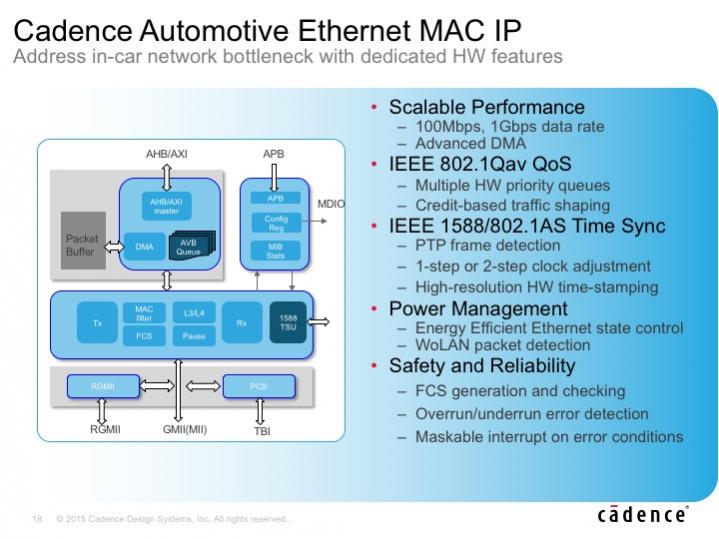I used to joke that my first car could survive a nuclear war. It was a 1971 Volvo sedan (142) that was EMP proof because it had absolutely no semiconductors in the ignition system, just points, condensers and a coil. If you go back to the Model T in 1915 you will see that the “on-board electronics” were not that different. However, today’s cars have an ever increasing amount of semiconductor content. Let’s just hope there are no EMP’s anytime soon.
Automotive electronics systems now have enormous requirements for computation, bandwidth and reliability. I attended a talk by Cadence’s Charles Qi at the recent TSMC Open Innovation Platform (OIP) Forum where he outlined the major trends in this area.
By comparison to current needs, the previous bandwidth requirements were quite low. Cars have used simple networks like CAN, but increasing complexity is leading to the adoption of Ethernet standards specifically adapted to automotive needs and environments. The diagram below highlights the kinds and numbers of systems that are going to be built into cars.

As you can tell, there is audio, visual and sensor data that needs to be handled. There are strict requirements for timely delivery of certain data in automotive systems. The umbrella term for this is AVB, or Audio Video Bridging. It is broken down into a set of IEEE standards within 802.1BA. These standards address time synchronization, traffic shaping and priority queuing. Below is a diagram that lists the applicable IEEE standards for automotive communication.

Ethernet offers many advantages. It can run over twisted pair, it can carry power and it is an established standard that will continue to provide legacy support for many years. Charles outlined Cadence’s IP offerings which address the evolving Ethernet communication needs in automotive applications. Here is his slide that summarizes Cadence’s solution.

Many of the systems in the first diagram require significant processing power. Today’s systems already perform Advanced Driver Assistance (ADAS), and will be pushed even further when self driving cars arrive in earnest. Already radar based features include front collision avoidance braking, adaptive cruise control and rear collision detection. Additionally, there are vision and audio/sound based systems that will require computing power.
Cadence is positioning its Tensilica IP as a solution for automotive processing. They have a power sipping architecture that can be fine tuned to specific applications; and the development tools work to create custom compilers and libraries for many of the coding needs encountered in developing systems for emerging automotive standards.
Tensilica also offers customizable DSP cores to further accelerate automotive product development. Their IVP DSP’s are well suited for ADAS development. The IVP DSP offers VLIW and 64 way SIMD. Coming in under 300mW, they offer impressive performance with minimal power draw. One of the most interesting slides was on the problem of pedestrian detection. ADAS systems will need to do this efficiently and reliably, even if the person only shows in as small an area as 64×128 pixels.
Charles also spoke about ISO26262; we will be hearing a lot more about this in the coming years. It is a comprehensive standard for ensuring functional safety starting at the requirements phase and going through implementation. Unlike phones and fitness computers, automotive electronics play a role in life or death situations. Everything designed for automotive applications will need to comply with ISO26262. Here is a slide from Charles’ talk that gives an overview.

Well, I am still waiting for my self driving car. However, it is clear that automobiles will be competing on a lot more than looks and horsepower. In the meantime I look forward to the increased safety and possibly easier driving that things like front collision avoidance braking and adaptive cruise control will offer. For more information on Cadence IP for automotive applicationslook here at their website.
Share this post via:





Comments
There are no comments yet.
You must register or log in to view/post comments.